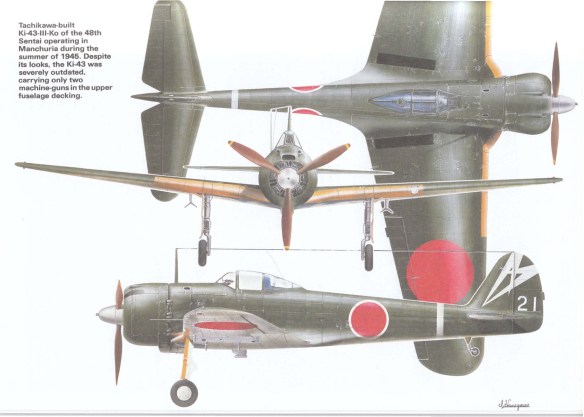The Ki-43 was the most widely-used Army fighter, and equipped 30 sentai (groups) and 12 chutais (independent squadrons). The first version, Ki-43-I, entered service in 1941, the Ki-43-II in December 1942, the Ki-43-II-Kai in June 1943, and the Ki-43-IIIa in summer 1944. The aircraft fought in China, Burma, the Malay Peninsula, New Guinea, the Philippines, South Pacific islands and the Japanese home islands.
Like the Zero, the Ki-43 initially enjoyed air superiority in the skies of Malaya, Netherlands East Indies, Burma and New Guinea. This was partly to do with the better performance of the Oscar and partly due to the relatively small numbers of combat-ready Allied fighters, mostly the P-36 Hawk, Curtiss P-40, Brewster Buffalo, Hawker Hurricane and Curtiss-Wright CW-21 in Asia and the Pacific during the first months of the war. As the war progressed, however, the fighter suffered from the same weaknesses as the Ki-27 “Nate” and the A6M Zero; light armor and less-than-effective self-sealing fuel tanks, which caused high casualties in combat. Its armament of two machine guns also proved inadequate against the more heavily armored Allied aircraft. As newer Allied aircraft were introduced, such as the P-47 Thunderbolt, P-38 Lightning, P-51 Mustang, F4U Corsair, F6F Hellcat and late-model Supermarine Spitfire/Seafire, the Japanese were forced into a defensive war and most aircraft were flown by inexperienced pilots. However, even towards the end, the Oscar’s excellent manoeuvrability could still gain advantage over rash Allied pilots. From October to December 1944, 17 Ki-43s were shot down in air combat, but they accounted for seven C-47s, five B-24 Liberators, two Spitfires, two Beaufighters, two Mosquitoes, two F4U Corsairs, two B-29 Superfortresses, one F6F Hellcat, one P-38, and one B-25. Like most Japanese combat types, many Hayabusas were at the end expended in kamikaze raids.
The Ki-43 also served in an air defense role over Formosa, Okinawa and the Japanese home islands. Some examples were supplied to the pro-Japanese regimes of Thailand, Manchukuo and Wang Jingwei Government as well. The Thai units sometimes fought against the USAAF in southern China.
Hayabusas were well liked in the JAAF because of the pleasant flight characteristics and excellent manoeuvrability, and almost all JAAF fighter aces claimed victories with Hayabusa in some part of their career. At the end of the war, most Hayabusa units received Ki-84 Hayate “Frank” fighters, but some units flew the Hayabusa to the end of the war. The top-scoring Hayabusa pilot was Sergeant Satoshi Anabuki with 39 confirmed victories, almost all of them scored with the Ki-43.
After the war, some captured examples served in limited numbers in the French Air Force in Indochina against Viet Minh rebels.
#
In December 1939 Nakajima was instructed by the Imperial Japanese Army to initiate development of a more advanced fighter to supersede the company’s own Ki-27, the first of three prototypes making its maiden flight during January 1939. A cantilever low-wing monoplane, this Kawasaki Ki-43 had retractable tail-wheel-landing gear, seated its pilot in an enclosed cockpit and was powered by Nakajima’s new supercharged Ha-25 Sakae radial engine with a take-off rating of 975 hp (727-kW). Service testing of the prototypes showed that the type met the specification, but manoeuvrability was so poor that, at one time, it seemed the new fighter was unlikely to be accepted by the army. However, 10 pre-production aircraft were ordered and in attempts to improve manoeuvrability, modifications were introduced. These included increased wing area, weight reduction and, finally, the incorporation of manoeuvring or so-called ‘combat’ flaps. This proved to be the answer to the problem, to the extent that the type was ordered into production as the Army Type 1 Fighter Model 1A Hayabusa (peregrine falcon), company designation Ki-43-1a. This version was armed with two 7.7-mm (0.303-in) machine-guns and carried two 33-lb (15-kg) bombs on external racks, but two sub-variants differed in armament, the Ki-43-1b having one 7.7-mm (0.303-in) and one 12.7-mm (0.5-in) and the Ki-43-1c two 12.7-mm (0.5-in) machine-guns. Production started in March 1941, and when the Ki-43 began to reach operational units it proved to be by far the most manoeuvrable fighter in the army’s inventory, enjoying considerable success in the early stages of the Pacific war. With the advent of more effective Allied fighters, however, the Ki-43’s shortcomings became apparent, leading first to the construction of five Ki-43-II prototypes for evaluation. These introduced the more powerful Nakajima Ha-115 engine, some armour protection for the pilot, and an early form of self-sealing fuel tank. Satisfactory testing brought construction of the initial Ki-43-IIa production version which had reduced wing span, a modified canopy, machine-gun armament as for the Ki-43-Ic, and two underwing racks each able to carry a 551-lb (250-kg) bomb; late series aircraft, designated Ki-43-IIb, were generally similar but for some equipment changes, and the final production Ki43-II KAI incorporated the progressive modifications introduced on Ki-43-IIa and Ki-43-IIb aircraft. Further development followed with the construction of 10 Ki43-IIIa prototypes, which were similar to the Ki-43-II KAI except for introducing the 1,150-hp (858-kW) Nakajima Ha-115-II engine to give improved performance at rated altitude, and two Ki-43-IIIb interceptor prototypes with the 1,300-hp (969-kW) Mitsubishi Ha112 engine and forward-firing armament of two 20-mm cannon, but neither of these versions entered production before the Pacific war ended.
Allocated the Allied codename ‘Oscar’, the Hayabusa remained in service from beginning to end of the Pacific war, taking an active part in operations for the defence of Tokyo, and by use in a kamikaze role. Production had totalled 5,919, built by Nakajima (3,239), Tachikawa (2,631) and the Army Air Arsenal at Tachikawa (49).
